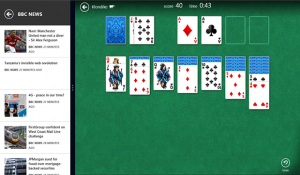Windows 8 in the enterprise: Fragmentation and deployment


The more information that comes to light about Windows 8, the more the dreaded "F" word comes to mind. When you think of fragmentation in the mobile space the first thing you think of is the Android platform. Volumes have been written about the forks in Android that are enough to drive enterprises batty. With so many versions and so many different devices to support, it's enough to give fits to IT folks tasked with making BYOD work.
The fragmentation issue should be a big factor driving the enterprise to Windows 8. Having a single business OS to deal with is an advantage not to be overlooked. The problem is that Microsoft in its desire to have Windows 8 run on both tablets and PCs has created a fork in the platform that complicates support by the enterprise.
There are two versions of Windows 8, the standard version for running on the Intel platform and the RT version for ARM-based devices like some tablets. Both versions have pros and cons that must be considered by the enterprise in determining which one to deploy. If employees are allowed to bring their own Windows gear to work, BYOD will likely see a collection of devices in the office running both versions of Windows 8.
"The Snap feature is a convenient tool for consumers in the new Windows 8 interface, but it does not currently support Outlook or other business applications." — HP
That will require IT departments to make sure that two different versions of Windows are fully supported - including the OS, the devices, and the apps they run. The latter is where fragmentation raises its ugly head as the apps could be different for the two distinct versions of Windows.
The new Metro-style apps that Microsoft is encouraging all developers to create should work on both Windows 8 proper and Windows RT. Legacy apps, all existing Windows apps that aren't specifically converted to Metro-style, will only run on full Windows (not RT). The IT folks will have to look at all apps deployed by the enterprise, and all apps employees run on BYOD equipment, to make sure they work. More importantly they will have to make sure they don't create unexpected problems.
That fragmentation alone complicates the deployment process and support for Windows 8 in the enterprise. Microsoft is pushing hard to get Windows 8 tablets, including its own Surface brand, into the enterprise to hurry adoption of the new platform. IT departments responsible for that deployment are going to have to carefully vet both the new hardware, the new OSes (Windows 8 and Windows RT), and also all apps that might be run.
Many large corporations have proprietary software they've created for use in their operations. They are legacy apps in their current form, meaning they won't run on Windows RT devices. The companies will have to make an effort (and investment) to convert those apps to Metro-style in order to ensure they will run on all Windows 8 devices. It's not clear how open they will be to a pretty big task just so they can deploy Windows 8.
In addition to this fragmentation built into Windows 8 itself, the recent announcement by HP of its new business tablet, the ElitePad 900, opens up another avenue of fragmentation for the IT departments to consider. The HP ElitePad is a nice tablet for the enterprise running Windows RT with one caveat.
Strangely, HP decided to make the tablet with a screen resolution smaller than the minimum required for Windows 8 to support the Snap view as detailed by Matt Baxter-Reynolds. That's the Windows 8 Metro feature that allows the user to "snap" one app to the side of the screen, keeping it visible while working in another app. It's an advantage Windows 8 has over all the mobile tablet competition, an important one for the enterprise.
In choosing to build this tablet that is incapable of using the Snap view, HP has created another fork in the as yet unreleased Windows 8 platform. Should companies deploy the ElitePad they now must also realize that if they convert their proprietary apps to Metro-style, even if they take care to make the converted apps work well in the Snap view environment, the effort will be wasted on this HP tablet. Not on most of the devices deployed, just this one (so far). That's the very definition of fragmentation as far as the enterprise goes, and one that needn't have been created if HP went with a standard screen resolution.
The new Windows 8 tablets from Microsoft and the standard players in the PC space look promising and could push the deployment of the new OS in the enterprise. Having to deal with the fragmentation created with the two different hardware versions of the OS complicates the deployment process for those companies. Adding the necessity to carefully vet which devices can take advantage of all new OS features and which can't will further complicate things.
Related stories:
Can the father of C# save us from the tyranny of JavaScript?
With a month to go until Windows 8's launch, 2,000-plus Windows store apps
Google and Windows 8, working together
Did Microsoft pull the trigger on Windows 8 too early?
Microsoft confirms October 25 launch for Windows 8
Windows 8 tablets: Vindication for the 'tablets do real work' crowd